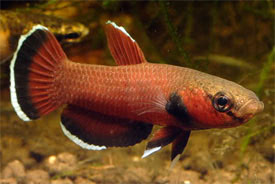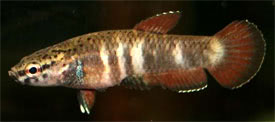
 Magyarul / Hungarian
Magyarul / Hungarian




- Scientific name: Betta channoides
- Common name: Snakehead betta
- Group: Labyrinth fishes
- Habitat:Asia; Indonesia, Borneo
- Size: 5-5,5 cm
- Biotope: Found in blackwater forest streams in Mahakam river basin, usually in shallow water among plant roots.
- Social behavior: Peaceful fish, they can be kept with very peaceful, small species. However it is best to keep them in a species tank.
- Diet: Omnivorous; in nature they eat small insects, in aquarium they accept live and frozen foods and even quality flake foods. Take care not to overfeed them.
- Breeding: Quite easy
- Tank: Minimum 40 litres
- Population: 4-5 fish for 80 litres
- Decoration: Prefers a tank with heavy vegetation and plenty of hiding places. Use floating plants to dim the lighting. Use peat filtered water to mimic their natural habitat.
- Temperature: 24-28 °C
- pH: 5-6.5
- Hardness: 0-5 NK°
- Lifespan: 3-5 years
Description: Betta channoides are rare in the shops, but because of their stunning adult coloration they are highly desired among hobbists. Very similar to Betta albimarginata, but Betta channoides are smaller and have rounder caudal fin. Snakehead betta males have a light gray base color and slightly darker fins when not displaying. However this coloration changes when they are in display: the body turns to a bright orange-red color and the black markings on the fins become pronounced, as the edges of the fins become bright white too. Females have light gray body with some irregular, dark vertical bars when displaying, while the fins are reddish.
Snakehead bettas are paternal mouthbrooders, the male’s head is larger, and their body is more colorful and possess white/black fin margins that are absent in females. Breeding is quite easy in a species tank with the correct water conditions and diet. The tank should have a tight fitting cover, as the fry need access to a layer of warm, humid air. Like other wild bettas, they can be induced to spawn after massive water change. The female initiates spawning by showing off her breeding coloration. Eggs and sperm are released during a typical labirinth fish position, where the male wraps his body around the female. After the eggs are fertilized by the male, the female collects them in her mouth and spit the eggs to the male and he can catch them as they sink to the bottom. Snakehead betta males are notorious for swallowing eggs after a few days, so it is better not to disturb the male during the incubation. The male will incubate the eggs for usually 12 days, and when ready he will release the small fry from his mouth. At this point the parents should be removed from the tank. The male needs a rest after incubating a brood, because he doesn’t eat during this time. Feed him with plenty of live foods to let him regain strength before spawning again. Feed the fry 2 -3 times a day with newly hatched brine shrimp, and do small daily water changes to keep the good water quality. The fry grow quickly and will reach sexually maturity at 4 months of age.









